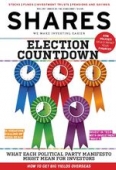Archived article
Please note that tax, investment, pension and ISA rules can change and the information and any views contained in this article may now be inaccurate.
What could the election mean for your finances?

Deciding how to vote in a general election is something of a minefield. Not only is each party attempting to convince you it has the right answer on a vast array of major topics – they also rubbish the claims of others.
Amidst this noise, it can be difficult to decipher who has said what and, more importantly, what it will mean for you.
With that in mind, we thought it would be useful to trawl through the details of the Labour and Conservative manifestos and pick out the bits that will affect investors at different stages of their life.
We have split the analysis into three broad social categories – young savers, working families and those who have retired.
To do this, we have made the following broad assumptions:
Younger savers
• Likely to be renting or saving for a first home
• Just started putting money aside for retirement
• Unlikely to be close to the existing higher rate tax threshold (£45,000)
Working families
• More likely to own their own home (or be in the latter stages of saving for a home)
• More likely to be a higher or even additional rate taxpayer
Retired
• Likely to have paid off, or be close to paying off, mortgage on their home
• Likely to be in receipt of the state pension
• More likely to need to pay for care
Clearly this is for illustration purposes only and there will be many policies that, to a greater or lesser extent, affect people across all age groups.
Furthermore, this is just a snapshot of the policies we believe – based on what’s in the manifestos – could impact on peoples’ finances.
1 YOUNGER SAVERS
Both the Labour and Conservative manifestos are lacking in proposals to win the vote of our younger saver, particular versus our retired voter.
This is hardly surprising – analysis of the 2015 general election by Ipsos MORI reveals 78% of over 65s voted, compared to just 43% of those aged 18 to 24 and 54% of 25 to 34-year-olds.
Conservatives
The Conservative’s promise to raise the personal allowance to £12,500 by 2020 will boost most workers, but the benefit will be greater as a percentage of income for those on lower wages.
Around 24m basic-rate taxpayers will be £33 a year better off (in today’s prices) under the plans, according to think-tank the IFS.
The party points to the Lifetime ISA – a policy it has already introduced – as evidence of its commitment to helping younger people get on the housing ladder and save for retirement.
In addition, the Tories want to increase the Living Wage – currently set at £7.50 per hour – to 60% of median earnings by 2020.
Labour
Labour, on the other hand, says it will not impose an increase in income tax for those earning below £80,000 and guarantees personal National Insurance contributions and VAT will not go up.
It has also promised to ‘restore confidence’ in workplace pensions and ‘end rip-off fees and charges’.
There is little detail on what exactly this means, although it would be no surprise if a Labour government looked to impose a stricter charge cap than the existing 0.75% that is applied to workplace pension investment funds.
On the housing front, Labour has promised to keep the Help to Buy shared ownership scheme in place until 2027.
Finally, the party has pledged to boost the living wage to £10 an hour by 2020.
2 WORKING FAMILIES
For those who are in work, earning money and saving for retirement, both the major parties’ manifestos contain key promises that could sway how you vote on 8 June.
Conservatives
While Theresa May has made it clear she is willing to intervene in certain markets – such as energy – the prime minister remains a traditional low-tax Conservative.
To this end, the party’s manifesto commits to raising the higher-rate tax threshold to £50,000 from 2020.
Combined with the planned increase to the personal allowance, higher-rate taxpayers would gain £208 per year in total, the IFS says, while the highest-income 0.5m individuals – who do not get a personal allowance – would gain £175 per year.
The state pension age will also likely rise under a Tory government, with the party saying future changes need to ‘reflect increases in life expectancy, while protecting each generation fairly’.
This could mean that people in their early 40s today will have to wait until age 68 to receive their state pension, while younger voters could face a state pension age closer to 70.
The party also wants to extend automatic enrolment to the self-employed. Such a move would be a huge benefit to millions of people, although how exactly it would be done remains to
be seen.
Labour
Higher earners will face paying more tax under a Labour government, with earnings over £80,000 taxed at 45% and a new 50% tax band introduced for those earning over £123,000.
Jeremy Corbyn also plans radical changes to the state pension age for future retirees, with the party pledging to halt all state pension age rises beyond age 66 and instigate a review of the system.
This review would take into account, among other things, variations in life expectancy experienced by people working in different industries.
3 RETIREES
Given their propensity to vote, it’s no surprise to see both the Conservatives and Labour unveiling a string of policies to woo older voters.
Conservatives
On the state pension, the Conservatives have promised to retain the ‘triple-lock’ – which guarantees the payment rises in line with the highest of earnings, prices or 2.5% – until 2020. This will then be replaced with an earnings/prices ‘double-lock’.
Social care was the other big issue tackled by the manifesto, with the Tories promising to set a £100,000 capital floor.
Theresa May subsequently ‘clarified’ that a cap on overall care costs would also be introduced, although a figure has not yet been set out.
Labour
Labour has pledged to keep the triple-lock for the entirety of the next Parliament and retain the winter fuel allowance and free bus passes.
The party will also inject an extra £8bn into the social care budget over the next five years, promising to cap lifetime care costs, increase the asset threshold below which people are entitled to state support, and provide free end of life care.
Tom Selby
Senior analyst, AJ Bell
Important information:
These articles are provided by Shares magazine which is published by AJ Bell Media, a part of AJ Bell. Shares is not written by AJ Bell.
Shares is provided for your general information and use and is not a personal recommendation to invest. It is not intended to be relied upon by you in making or not making any investment decisions. The investments referred to in these articles will not be suitable for all investors. If in doubt please seek appropriate independent financial advice.
Investors acting on the information in these articles do so at their own risk and AJ Bell Media and its staff do not accept liability for losses suffered by investors as a result of their investment decisions.

 magazine
magazine











